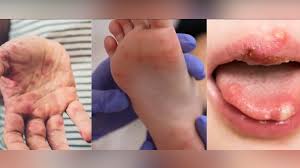Hand, foot and mouth disease sweeps through Tennessee schools: What parents need to know about the growing outbreak

Hand, foot and mouth disease sweeps through Tennessee schools: What parents need to know about the growing outbreak
A worrying outbreak of Hand, Foot and Mouth Disease (HFMD) has struck Tennessee, spreading rapidly through 31 schools and three childcare centres and affecting at least 178 students and staff since late August. Health officials have described the situation as “very contagious but not usually serious” — yet the rising number of cases has parents and educators on edge.
HFMD is a viral illness that mainly targets young children, though health experts are warning that older children and even adults can now contract it. Characterized by painful mouth ulcers, fever, and rash or blisters on the hands and feet, the infection typically runs its course within 7–10 days. However, the discomfort and risk of dehydration in children make it a challenging illness for families to manage.
A Season of Surprising Infections
Traditionally, HFMD peaks between May and October, but doctors say the trend has shifted in recent years.
Dr. Manisha Desai, a pediatric specialist in Odessa, noted that the pattern of viral outbreaks changed significantly after the COVID-19 pandemic.
“With the disruption of herd immunity during the lockdowns, we’re now seeing viruses like HFMD appear outside their usual seasons — even in cooler months,” she explained.
Health professionals in Tennessee and other parts of the U.S. have observed the same phenomenon, with more older children and even adults now testing positive for HFMD. This unexpected demographic shift has increased transmission risks in schools, daycare centres, and workplaces.
How It Spreads — and Why It’s Hard to Contain
Hand, Foot and Mouth Disease spreads through respiratory droplets, saliva, blister fluid, and feces. It can also survive on surfaces like toys, doorknobs, and classroom tables for hours. Public health experts emphasize that good hygiene is the best defense.
According to Public Health Isle of Man, the virus can remain in an infected person’s saliva or stool for several weeks — even after visible symptoms disappear. This means ongoing cleaning and cautious hygiene practices are vital to curb community spread.
Parents are advised to:
-
Wash hands regularly with soap and water for at least 20 seconds.
-
Disinfect frequently touched items like toys, utensils, and bedding.
-
Avoid sharing cups, towels, or cutlery with infected individuals.
-
Keep sick children at home until they are fever-free for at least 24 hours.
Eva Rodriguez, Vice President of Student Health and Wellness at IDEA Public Schools, also reminds families that handwashing should be frequent and thorough. “It takes about as long as singing ‘Happy Birthday’ twice — that’s how long proper washing should last,” she said.
Treatment and Recovery: What Parents Should Do
While HFMD looks alarming, there’s no specific antiviral treatment. Most cases resolve naturally within 10 days.
Doctors recommend managing symptoms with pain relievers like ibuprofen or acetaminophen, keeping children hydrated, and offering soft, cold foods to ease mouth pain.
Dr. Desai stresses the importance of monitoring for subtle signs of distress: “Parents should watch for irritability, reduced appetite, or fatigue, which might indicate dehydration or discomfort.”
Children who recover should still maintain strict hygiene for several weeks to prevent further transmission.
A Manageable but Persistent Threat
Despite its rapid spread, health officials maintain that HFMD remains a mild and manageable illness. Most children recover fully without complications, and long-term effects are rare. However, public health authorities in Tennessee are continuing to monitor the outbreak closely, urging schools and families to stay vigilant.
Eva Rodriguez offers reassurance to parents: “Hand, foot and mouth disease is common and completely treatable. The key is calmness, cleanliness, and care.”
FAQs
1. How many people have been affected by HFMD in Tennessee?
At least 178 students and staff from 31 schools and 3 childcare centres have been impacted since late August 2025.
2. What are the main symptoms of HFMD?
Symptoms include fever, sore throat, mouth ulcers, and a rash or blisters on the hands, feet, and sometimes the diaper area.
3. Is HFMD dangerous?
HFMD is usually mild but very contagious. Severe complications are rare.
4. Can adults get HFMD?
Yes. Though common in children under 10, more adults have been infected in recent years.
5. How long does it last?
Symptoms typically last 7–10 days, and recovery occurs without specific medication.
6. When should a child stay home from school?
A child should remain home until they’ve been fever-free for 24 hours and feel well enough to participate in school activities.

